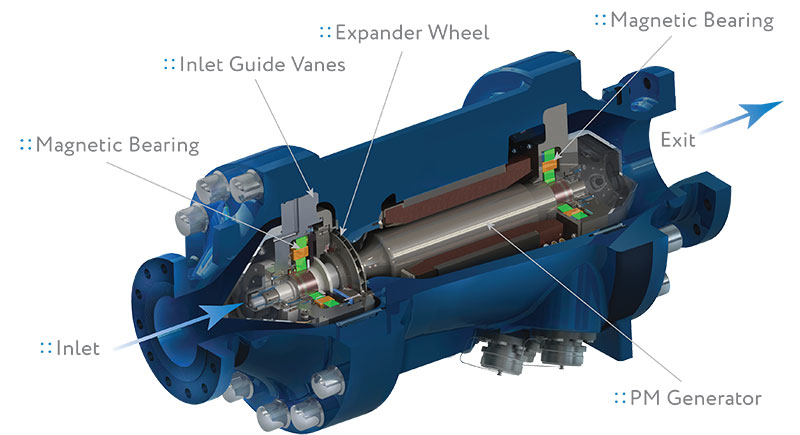October 2021, Vol. 248, No. 10
Tech Notes
Cost-Effective Energy Recovery for Gas Pipeline Pressure Letdown Stations
Special to P&GJ
It has long been recognized that the mechanical devices used at pressure letdown (PLD) stations in gas pipelines generate significant amounts of waste energy, which potentially could be captured and converted to electric power.
While turboexpanders are often used for energy recovery across other industrial sectors, such as refineries, gas liquefaction, petrochemicals and steam PLD, their high capital and operating costs have presented a barrier to widespread deployment in gas pipeline PLD stations.
Sapphire Technologies, a subsidiary of Calnetix Technologies, is addressing the issue by harnessing high-speed magnetic technologies with a turboexpander generator that converts the kinetic energy produced by the PLD process into usable electrical energy. The clean electricity produced can be used locally or sold back to the grid.
Sapphire has developed and deployed an integrated system that contains a high-speed turboexpander driving a synchronous permanent-magnet high-speed generator levitated on non-contact active magnetic bearings. All the components are contained in a hermetically sealed flow-through unit, which can be inserted directly into a section of piping in parallel with the existing mechanical pressure reducing valve.
Active magnetic bearings are a key element in the system’s architecture, according to Sapphire’s CEO, Freddie Sarhan, who explains that other types of bearing systems, such as traditional rolling element bearings, are not suitable for the process gas environment since they can leak lubricant into the process gas and have high operating costs. By supporting the rotor with frictionless magnetic bearings, system efficiency is maximized and maintenance costs are minimized.
Conventional mechanical turboexpander generators typically require large gear boxes to regulate the speed of the expander turbine and a lubrication system consisting of an oil reservoir, pump cooler, filters, piping and seals. Experience has shown that the lubrication system is the least reliable component in the overall installation, according to Sarhan.
Since the active magnetic bearings ensure that moving parts never come into direct contact with each other, there are no friction losses, and there is no need for an auxiliary lubrication system, lowering the risk of oil contamination and enabling a much smaller footprint.
Sarhan expects the flow-through turboexpander generator design to be applicable for hydrogen, in addition to natural gas. He points out that while hydrogen usage is expected to grow substantially over the next 10 years, the high cost of production, storage and transportation remains a barrier.
These costs can be offset considerably by installing turboexpander generators at various points throughout the hydrogen infrastructure. The captured waste energy can be converted to electricity with no carbon emissions. Preliminary analysis reveals an estimated payback period of two years, according to Sarhan.






Comments